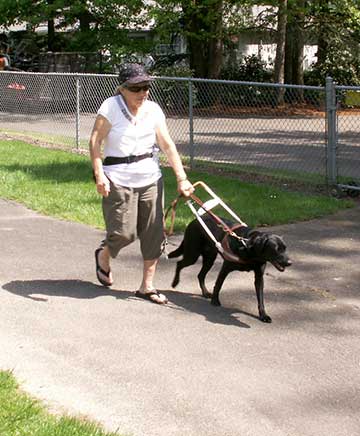 |
Previous Issues |
| Cedar Mill Community Website |
|
Search the Cedar Mill News: |
About The Cedar Mill News |
|
|||||||
| Volume 13, Issue 5 | May 2015 |
||||||
Paws for Independence
|
||||
 |
| Sue Phillips and Kabuki. Sue is a member of the Golden Dragons dragonboat team, which will be competing in the upcoming Rose Festival on June 5-6. Members of the team are all over 50 years old. |
She’d witnessed her neighbors raising puppies for Guide Dogs for the Blind, and marveled at how smart and kind they were. Additionally, she’d gone out to see the GDB campus with the Commission for the Blind, and thought that a dog would be a great fit.
Guide Dogs for the Blind partners legally blind individuals with highly trained dogs, creating a powerful team. Since its founding in 1942, GDB has graduated 12,500 working teams. Currently, more than 2200 teams work in the U.S. and Canada. GDB is headquartered in San Rafael California, with a local campus in Boring Oregon. This proximity appealed greatly to Phillips, as having family nearby was a key component in her journey.
A person is considered legally blind when his or her central visual acuity is 20/200 or less in the better eye, with the best possible correction, or when his or her visual field is 20 degrees or less. While an individual needs to be at least 16 years old to apply for a guide dog, no upper age cap exists, as long as the individual possesses the physical stamina to handle a dog,
GDB oversees every step of the process, from breeding dogs in San Rafael to providing follow up support and training to alumni. Along this road of development, a puppy learns socialization and obedience from a volunteer puppy raiser, living with that person for about a year. The dog then returns to campus for two-three months of formal guide dog training. The final instruction takes place when this dog meets his human partner and spends two additional weeks training with their person on campus.
The application process involves a few steps. An interested individual completes a paper application and a phone interview. An instructor then visits the individual in his or her home to continue the interview process and assess the individual’s level of independent travel. During this visit, the applicant has the opportunity to experience the sensation of holding a harness handle while walking; the instructor simulates these movements by maneuvering the harness. Once accepted, the individual waits to be placed in a class where he or she will be matched with a dog. Living on campus for two weeks, the individual learns how to both care for a dog and carry out effective guide work with this newfound friend. The training covers a wide spectrum of situations—from going on night walks, to working in the city, to navigating the airport. It’s tailored to the individual’s lifestyle.
Phillips graduated with her second guide, Kabuki, in 2012. She enjoys so much more with her canine partner by her side than she ever would have alone. “It’s an eye-opening experience, so to speak,” laughs Phillips. She and her guide confidently travel to the airport, downtown and the east side of Portland from their home in Cedar Mill. She uses the Trimet Lift, Trimet buses and MAX. She participates in dragon boat racing, which has taken her and her guide from Salem to Victoria to compete.
A guide dog provides worlds more than fostering independent travel. Not only are these “great dogs that help you regain your independence,” explains Phillips, “but they’re loving dogs that are always there for you.” Five months after being diagnosed with AMD herself, Phillips’ twin sister, Judy, received the same diagnosis. The sisters got into the same class and roomed together at the Boring campus. Judy’s guide remained faithfully beside her until Judy passed away last March, Phillips recalls.
Once admitted to the program, a blind person pays nothing for the dog, and all the training is free of charge. GDB is a nonprofit that receives no federal funding. Thousands of volunteers donate time and love to create this service.
“Just call them up and talk to them,” encourages Phillips. “It makes such a difference.” Contact GDB at 800-295-4050, or visit guidedogs.com for more information.
![]()
Like us on Facebook for timely updates
Published monthly by Pioneer Marketing & Design
Publisher/Editor:Virginia Bruce
info@cedarmillnews.com
PO Box 91061
Portland, Oregon 97291
© 2013